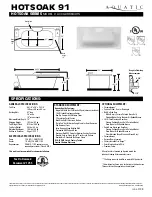
30
IMPORTANT “SUPER CHLORINATION/NON-CHLORINE SHOCK TREATMENT” NOTE:
After administering a super chlorination treatment or non-chlorine shock to
your spa, leave the cover open for a minimum of 20 minutes to allow the oxidizer gas to vent. A high concentration of trapped oxidizer gas which may exist as a result of
the shock treatment (not daily sanitation) may eventually cause discoloration or vinyl degradation to the bottom of the cover. This type of damage is considered chemical
abuse and is not covered under the terms of the limited warranty.
THE WATKINS
®
SPA WATER MAINTENANCE PROGRAM
Each step in your water maintenance program is dependent on the completion of the previous steps. Omitting a step or failing to reach the recommended range may
cause an imbalance in your water’s chemistry. Unbalanced water chemistry can damage the spa and its components, as well as cause discomfort for the user.
BALANCING THE TOTAL ALKALINITY (TA)
A. The recommended Total Alkalinity (TA) for your spa water is 125-150 ppm.
B. Total Alkalinity is a measure of the total levels of carbonates, bicarbonates, hydroxides, and other alkaline substances in the water. TA is referred to as the water’s
“pH buffer”. In other words, it’s a measure of the ability of the water to resist changes in pH level.
C. If the TA is too low, the pH level will fluctuate widely from high to low. Fluctuations in pH can cause corrosion or scaling of the spa components.
Low TA can be
corrected by adding sodium hydrogen carbonate (pH/Alkalinity Up).
D. If the Total Alkalinity is too high, the pH level will tend to be high and may be difficult to bring down.
It can be lowered by using sodium bisulfate(pH/Alkalinity
Down).
E. Once the TA is balanced, it normally remains stable, although the addition of more water with a high or low alkalinity will raise or lower the TA reading of the water.
F.
When the Total Alkalinity is within the recommended range, proceed to the next step.
BALANCING THE CALCIUM HARDNESS (CH)
A. The recommended Calcium Hardness (CH) level for your spa is 150-200 ppm.
B. Calcium Hardness is a measure of the total amount of dissolved calcium in the water. Calcium helps control the corrosive nature of the spa’s water. That’s why
calcium-low water (commonly known as “soft” water) is not recommended. It is very corrosive to the equipment, and can cause staining of the spa shell.
C. If the CH is too high (commonly known as “hard water”), formation of scale on the spa’s shell surface and equipment can result.
CH can be decreased by
dilution–a mixture of 75% hard and 25% soft water will usually yield a reading within the correct range.
If soft water is not available or practical for you, a
stain and scale inhibitor should be added to the spa water, according to label instructions.
D. If the CH is too low add CH Increaser.
E. Once the CH is balanced, it normally remains stable, although the addition of more water with a high or low calcium content will raise or lower the CH reading of the water.
F.
When the Calcium Hardness is within the recommended range, proceed to the next step.
BALANCING THE pH
A. The recommended pH level for your spa water is 7.4-7.6.
B. The pH level is the measure of acidity and alkalinity. Values above 7 are alkaline; those below 7 are acidic. Maintaining the proper pH level is extremely important for:
• Optimizing the effectiveness of the sanitizer.
• Maintaining water that is comfortable for the user.
• Preventing equipment deterioration.
C. If the spa water’s pH level is too low, the following may result:
• The sanitizer will dissipate rapidly.
• The water may become irritating to spa users.
• The spa’s equipment may corrode.
If the pH is too low, it can be increased by adding sodium hydrogen carbonate (pH/Alkalinity Up).to the spa
water.
D. If the pH level is too high, the following may result:
• The sanitizer is less effective.
• Scale will form on the spa shell surface and the equipment.
• The water may become cloudy.
• The filter cartridge pores may become obstructed.
If the pH is too high, it can be decreased by adding sodium bisulfate (pH/Alkalinity Down) to the spa water.
NOTE:
After adding sodium hydrogen carbonate, or sodium bisulfate,
wait two hours
before testing the water for
pH. Measurements taken too soon may not be accurate.
E. It is important to check the pH on a regular (weekly) basis. The pH will be affected by the bather load, the addition of new water, the addition of various chemicals,
and the type of sanitizer used.
F.
When the pH is within the recommended range, proceed to the final step.
WATER QUALITY AND MAINTENANCE












































